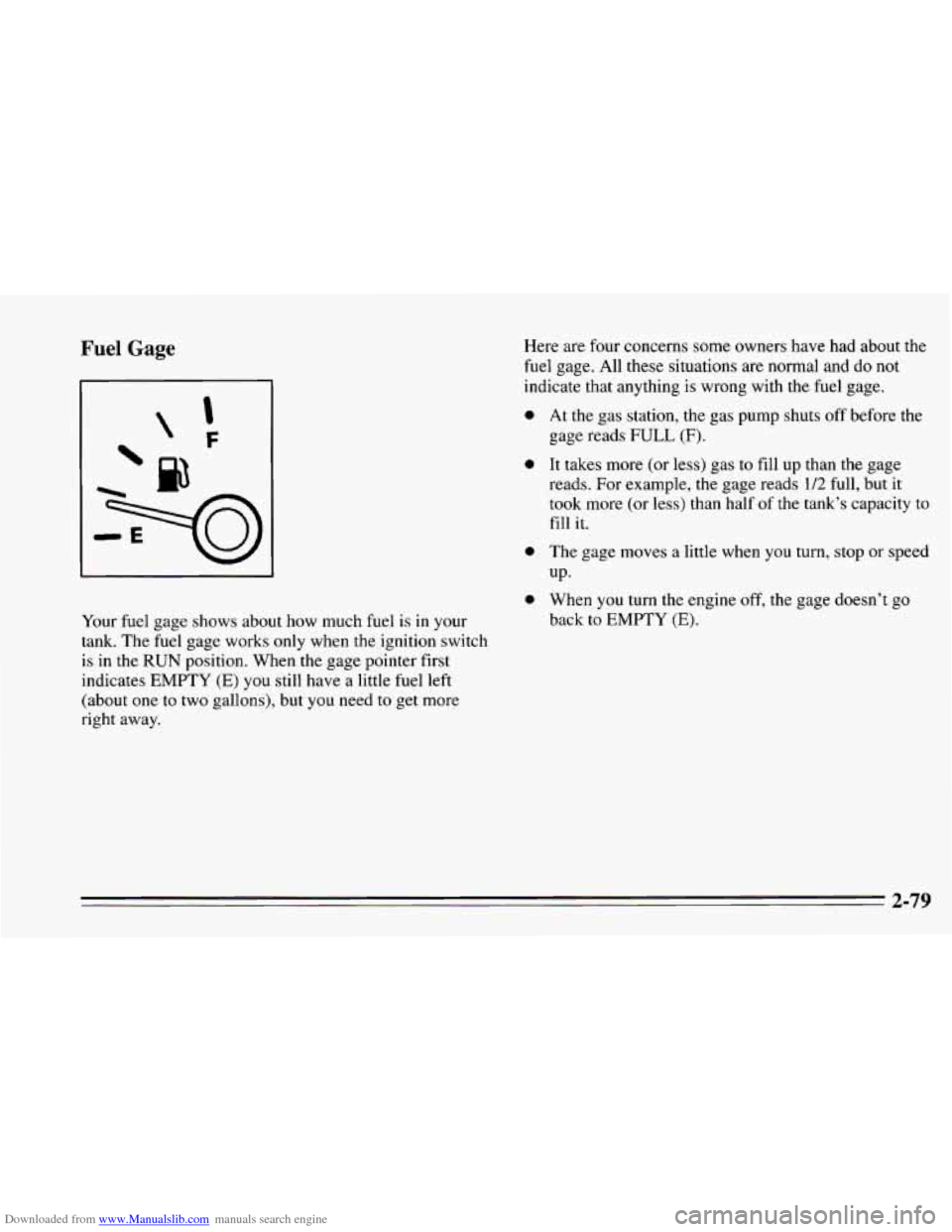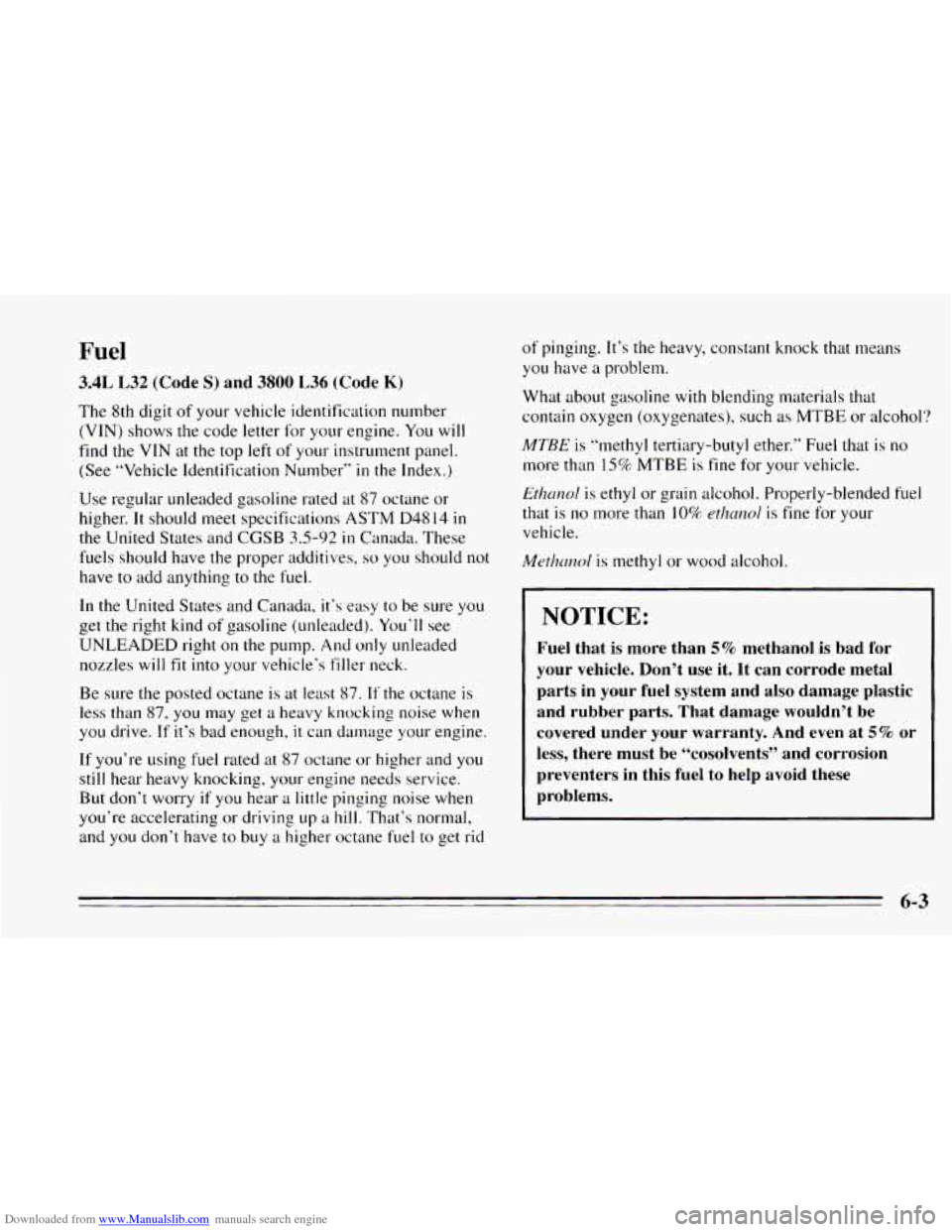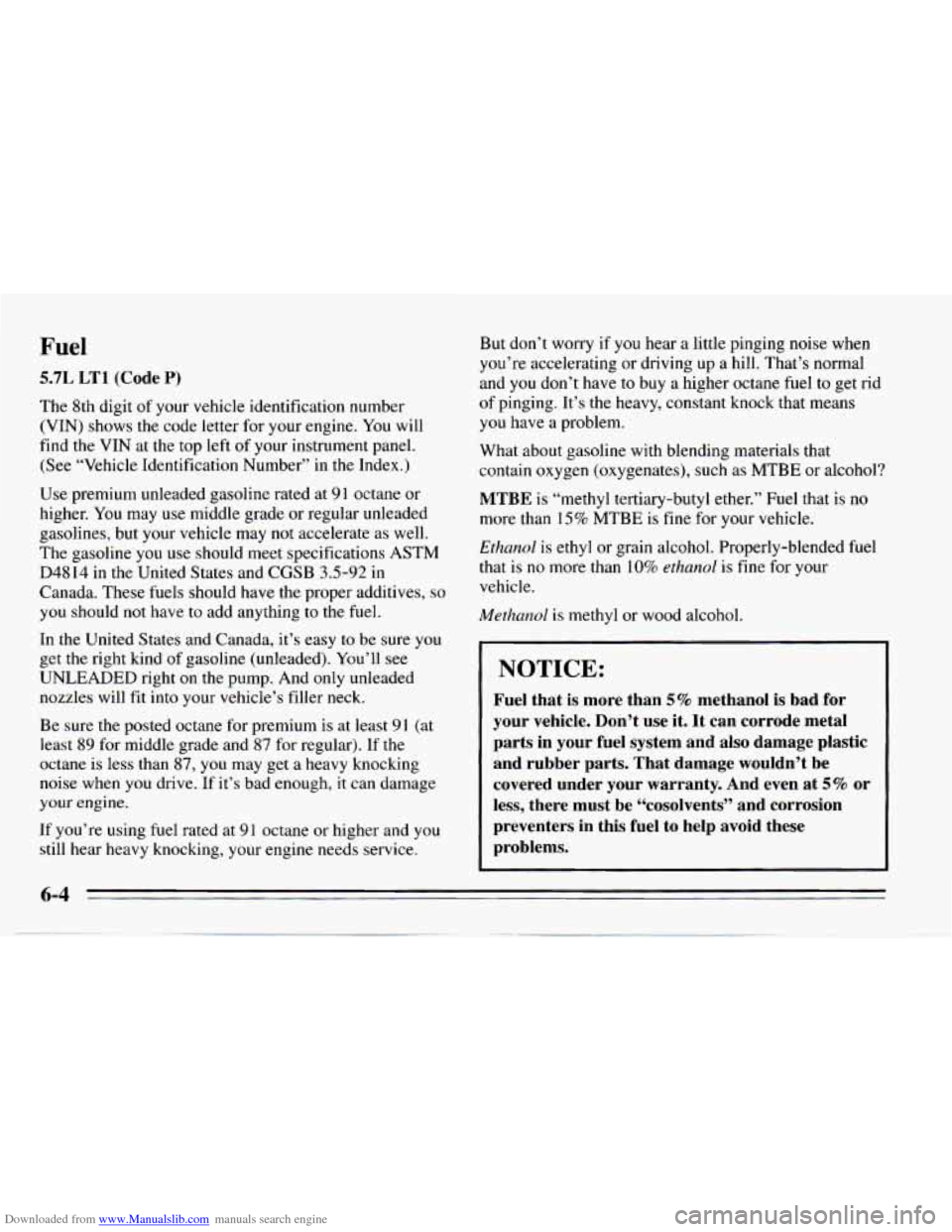1995 CHEVROLET CAMARO fuel pump
[x] Cancel search: fuel pumpPage 131 of 388

Downloaded from www.Manualslib.com manuals search engine Fuel Gage Here are four concerns some owners have had about the
fuel gage. All
these situations are normal and do not
indicate that anything is wrong with the fuel gage.
0
0
0
0
Your fuel gage shows about how much fuel is in your
tank. The fuel gage works only when the ignition switch
is in the RUN position. When the gage pointer first
indicates EMPTY
(E) you still have a little fuel left
(about
one to two gallons), but you need to get more
right away. At the
gas station,
the gas pump shuts off before the
gage reads
FULL (F).
It takes more (or less) gas to fill up than the gage
reads. For example, the gage reads 1/2 full, but
it
took more (or less) than half of the tank’s capacity to
fill
it.
The gage moves a little when you turn, stop or speed
UP.
When
you turn the engine off, the gage doesn’t PO
back to EMPTY (E),
Page 235 of 388

Downloaded from www.Manualslib.com manuals search engine Fuel
3.4L L32 (Code S) and 3800 L36 (Code K)
The 8th digit of your vehicl,e identification number
(VIN) shows the code letter for your engine. You will
find the
VIN at the top left of your instrument panel.
(See “Vehicle Identification Number”
in the Index.)
Use regular unleaded gasoline rated at
87 octane or
higher.
It should meet specifications ASTM D4814 in
the United States and CGSB 3.5-92 in Canada. These
fuels should have the proper additives,
so you should not
have to add anything to the fuel.
In the United States and Canada, it‘s easy to be sure you
get
the right kind of gasoline (unleaded). You’ll see
UNLEADED right on the pump, And only unleaded
nozzles will
fit into your vehicle‘s filler neck.
Be sure the posted octane is at least
87. If‘ the octane is
less than
87, you may get a heavy knocking noise when
you drive. If it’s bad enough, it can damage your engine.
If you’re using fuel rated at
87 octane or higher and you
still hear heavy knocking, your engine needs service.
But don’t worry
if you hear a little pinging noise when
you’re accelerating or driving up
a hill. That’s normal,
and
you don’t have to buy a higher octane fuel to get rid of
pinging. It’s the heavy, constant knock that means
you have a problem.
What about gasoline
with blending materials that
contain oxygen (oxygenates), such as
MTBE or alcohol?
MTBE is “methyl tertiary-butyl ether.” Fuel that is no
more than
15% MTBE is fine for your vehicle.
Etl?mol is ethyl or grain alcohol. Properly-blended fuel
that is no more than 10%
ethuuol is fine for your
vehicle.
Metlwrnof is methyl or wood alcohol.
NOTICE:
Fuel that is more than 5% methanol is bad for
your vehicle. Don’t use it.
It can corrode metal
parts in your fuel system and also damage plastic
and rubber parts. That damage wouldn’t be
covered under your warranty. And even at
5% or
less, there must be “co~oIvent~’’ and corrosion
preventers in this fuel to help avoid these
problems.
6-3
Page 236 of 388

Downloaded from www.Manualslib.com manuals search engine Fuel
5.7L LT1 (Code P)
The 8th digit of your vehicle identification number
(VIN) shows the code letter for your engine.
You will
find the
VIN at the top left of your instrument panel.
(See “Vehicle Identification Number” in the Index.)
Use premium unleaded gasoline rated at
91 octane or
higher.
You may use middle grade or regular unleaded
gasolines, but your vehicle may
not accelerate as well.
The gasoline you use should meet specifications ASTM
D4814 in the United States and
CGSB 3.5-92 in
Canada. These fuels should have the proper additives,
so
you should not have to add anything to the fuel.
In the United States and Canada, it’s easy to be sure you
get the right kind of gasoline (unleaded). You’ll see
UNLEADED right on the pump. And
only unleaded
nozzles will fit into your vehicle’s filler neck.
Be sure the posted octane for premium is at least
9 I (at
least
89 for middle grade and 87 for regular). If the
octane is less than
87, you may get a heavy knocking
noise when
you drive. If it’s bad enough, it can damage
your engine.
If you’re using fuel rated at
9 1 octane or higher and you
still hear heavy knocking, your engine needs service. But don’t worry
if
you hear a little pinging noise when
you’re accelerating or driving up
a hill. That’s normal
and
you don’t have to buy a higher octane fuel to get rid
of pinging.
It’s the heavy, constant knock that means
you have a problem.
What about gasoline with blending materials that
contain oxygen (oxygenates), such as MTBE or alcohol?
MTBE is “methyl tertiary-butyl ether.’’ Fuel that is no
more than 15% MTBE is fine for your vehicle.
Ethanol is ethyl or grain alcohol. Properly-blended fuel
that
is no more than 10% ethanol is fine for your
vehicle.
Methanol is methyl or wood alcohol.
I NOTICE:
Fuel that is more than 5% methanol is bad for
your vehicle. Don’t use it. It can corrode metal parts in your fuel system and also damage plastic
and rubber parts. That damage wouldn’t be
covered under your warranty. And even at
5% or
less, there must be “cosolvents” and corrosion
preventers in this fuel to help avoid these
problems.
6-4
Page 303 of 388

Downloaded from www.Manualslib.com manuals search engine 1. ABS BAT Electronic Brake Control Module
2. FOG LTS: Fog Lamps
3. Not Used
4. Not Used
5. ABS IGN: Anti-Lock Brake System
6. FAN/ACTR: Coolant Fan Relays; EVAP Canister
Purge Solenoid; Exhaust Gas Recirculation; Low
Coolant Re1ay;Reverse Lockout Solenoid
7. AIR PUMP: Air Injection Pump Assembly; Air
8. PCM: Power Train Control Module
Pump
Relay
9. INJECTOR: Fuel Injectors
10. INJECTOR: Fuel Injectors
11. IGNITION: VIN Engine Code S: Camshaft Position
Sensor;Crankshaft Position Sensor; Electronic
Ignition Module VIN Engine Code P: Ignition Coil; Ignition Coil Driver
Cruise Control Switches and Module
12. A/C-CRUISE: Air Conditioning Compressor Relay;
Relays
B --Air Conditioning Compressor
C --Anti-Lock Brake System
D --Primary Coolant Fan (Driver Side)
E--Air Pump
F --Secondary Coolant Fan (Passenger Side)
G--ASR
H--Fog Lamps
J--Not Used
6-71
Page 304 of 388

Downloaded from www.Manualslib.com manuals search engine Main Fuse Block
FUSE USAGECHART I I
I ”- RADIO
€I 160 ACCY CRANK
WINDOWS BATT WIPER/WASH IP DIMMER IGN
12[--1 11- gn
80 70 60 50
DEFOG/SEATS CIGAR/HORN TAIL LTS GAGES
COURTESY PWR
ACCY STOPIHAZARD PCM ION
RADIO ACCY TURN B- U AIR BAG
SEE OWNER’S MANUAL FOR MORE INFORMATION
PRINTED IN U.S.A 10264034
1. AIR BAG: SIR Components
2. TURN B-U: Backup Lamp; Daytime Running
Lamps Module (Canada); Turn Flasher
3. HVAC: Heater Control Selector Switch (Heater/Air
Conditioner); Rear Defogger
4. RADIO ASSY: BOSE’ Relay
5. PCM IGN: Powertrain Control Module; PASS-Key
II@Decoder Module; Fuel Pump Relay
6.
7.
8.
9.
STOPEIAZARD: Brake Lamp/Cruise Release
Switch; Hazard Flasher
PWR ACCY Power Door Locks; Power Mirrors;
Hatch Release
COURTESY: Audio Alarm Module; Courtesy
Lamps: Console Compartment, Glove
Box, Dome,
Trunk, Rear Courtesy, Rearview Mirror and Radio
GAGES: Audio Alarm Module; Daytime Running
lamps Module (Canada); Diagnostic Energy Reserve
Module; Instrument Cluster; Remote Lock Control
Module
10. TAIL LTS: Exterior Lighting
11. CIGAWORN: Cigarette Lighter; Horn Relay
12. DEFOG/SEATS: Power Seats; Rear Defogger
13. IP DIMMER: Brightness Control
14. WIPEIUWASH: Windshield WiperNasher
15. WINDOWS: Power Windows, Convertible Top
(Circuit Breaker)
Switch (Circuit Breaker)
16. CRANK: Diagnostic Energy Reserve Module
17. RADIO: Radio Amplifier